Oklahoma Highway Patrol
Oklahoma Highway Patrol
Tradition, honor, pride, dedication and professionalism. These qualities are instilled in every member of the Oklahoma Highway Patrol from the first day they report to the academy as cadets. The 125 troopers that graduated the first academy in 1937 began a tradition that has continued to thread its way through the organization’s history. A tradition that distinguishes the state law enforcement agency from all others. The tradition begins with a military-style academy that instills professional qualities in all troopers that stay with them throughout their careers.
In 1937, the new state troopers met resistance from Oklahoma motorists who were not used to living within the bounds of traffic regulations when none had ever before existed. But the troopers were prepared for this as they paved the way for all future officers by exerting good manners and service to all citizens. A total of 288,277 warnings compared with only 5,518 arrests and citations were written in the first nine months of patrol. Even today, motorists will declare that troopers are well-mannered, friendly and hospitable while maintaining an unrivaled level of professionalism.
With almost 800 troopers statewide, the division has grown into several areas of special services including Public Information, Capitol Patrol, Lake Patrol, Training, Bomb Squad, Motorcycle, Tactical Teams, Special Operations, Aircraft, Audits and Fraudulent Driver License. The department revived "The Flying Squadron", a motorcycle division that utilizes Harley Davidson motorcycles. A bomb squad was organized who operate state-of-the-art equipment unparalleled in Oklahoma including two bomb trucks and robots. The east and west tactical teams continue to send their troopers through specialized training programs that elevate them to the best in the state. Special Operations, formerly Criminal Interdiction, now has troopers who each have a well-trained drug canine.
The agency has stepped in the 21st century with top-rate troopers and equipment, considered first-rate by many throughout the nation.
Prior to the formal creation of the Oklahoma Highway Patrol in 1937, traffic laws in the Sooner State were enforced by the Oklahoma Highway Commission Enforcement Officers since 1923. The OHCEO had five patrol cars in 1935, and it was believed that they utilized "Dollar tag" license plates on their patrol cars. The Dollar tag was known as such since tax exempt license plates in Oklahoma at the time cost one dollar and the word DOLLAR was embossed at the top of the plate! These Dollar plates were also made available to disabled veterans and to replace lost or stolen license plates previously paid for.
 1935 "Dollar tag" of the type believed used by enforcement officers of the Oklahoma Highway Commission prior to the formation of the Highway Patrol. The term DOLLAR indicated the cost of the plate registration for tax exempt vehicles.
1935 "Dollar tag" of the type believed used by enforcement officers of the Oklahoma Highway Commission prior to the formation of the Highway Patrol. The term DOLLAR indicated the cost of the plate registration for tax exempt vehicles. 
In 1936, state vehicles in Oklahoma, including those of the OHCEO were issued distinctive license plates that differentiated them from the "Dollar tag" crowd.
The new state government license plates were made of embossed steel and measured 6" x 12 3/8" with a total of four mounting holes on the top of the plate, and four mounting holes on the bottom of the plate. The color scheme was black raised characters over a deep yellow background. An embossed shape of the state occupied the interior portion of the plate with OKLAHOMA-1936 embossed across the top of it and a number in the 1-234 format below it. Below the panhandle section of the plate was a highly-detailed screened image of the state seal.
This style of plate is believed to have continued but with annual color scheme variations until 1941, however no issues after 1938 have been documented as of this writing.
 Fleet servicing for OHP 1936.
Fleet servicing for OHP 1936. 1936 State Exempt issue.
1936 State Exempt issue. 
 1937 State Exempt issue.
1937 State Exempt issue. 
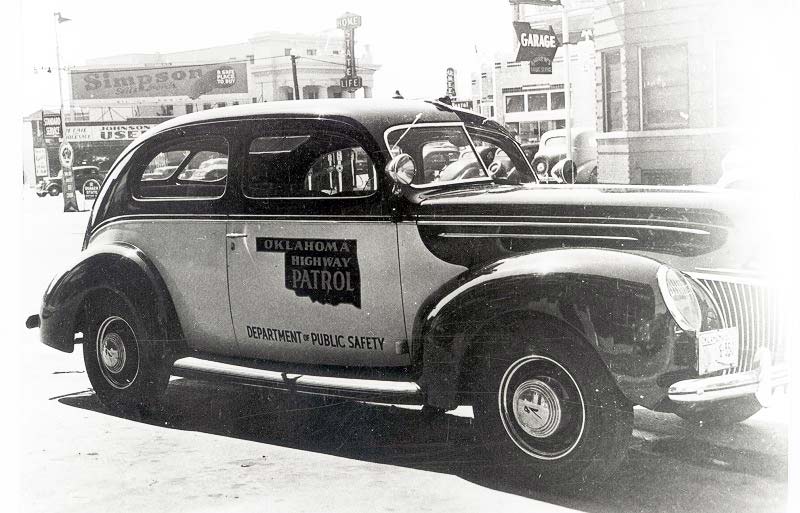
 1938 State Exempt issue.
1938 State Exempt issue.  1938
1938 1941 State Exempt issue.
1941 State Exempt issue. 
As for license plate issuance for the Oklahoma Highway Patrol after 1939, it is a mystery until 1968. Some people attest that only passenger car license plates were issued to OHP cars during that time, others say Tax Exempt plates were used, others say both, some say that no plates at all were used. Either way, there appears to have been a lack of people willing to photograph or record any of the license plate usage for the OHP during this thirty year period.
As a result, we have opted to post photos of Tax Exempt license plates until confirmation proving otherwise is received, as the trend of state tax exempt license plates would have been likely to have continued as they were confirmed resumed for OHP use in 1968.
The earliest of these types measured only 5 inches by 9 inches as a measure to conserve metal for the efforts during World War Two. These small tax exempt plates continued being issued until 1959, long after the war had ended.
 1944 Tax Exempt issue. Embossed steel
1944 Tax Exempt issue. Embossed steel
 1945 Tax Exempt issue. Embossed steel
1945 Tax Exempt issue. Embossed steel
 1947 Tax Exempt issue. Embossed steel
1947 Tax Exempt issue. Embossed steel
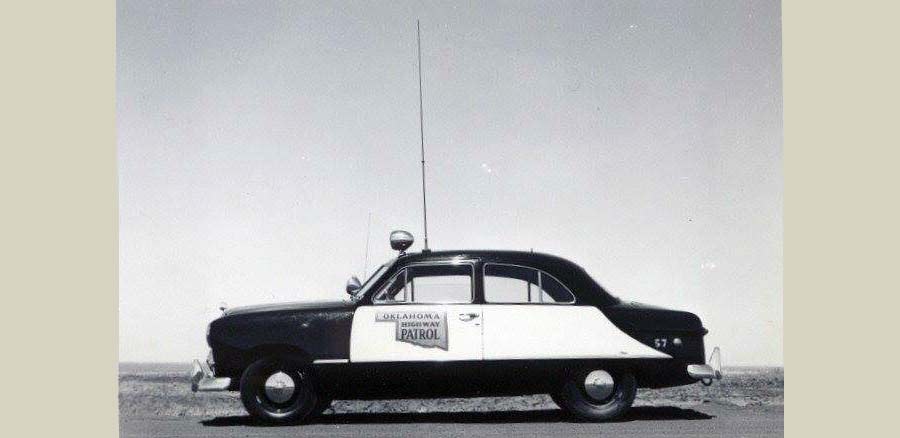
 1949 Tax Exempt issue. Embossed steel
1949 Tax Exempt issue. Embossed steel

 1953 Tax Exempt issue. Embossed steel
1953 Tax Exempt issue. Embossed steel

 1954 Tax Exempt issue. Embossed steel
1954 Tax Exempt issue. Embossed steel

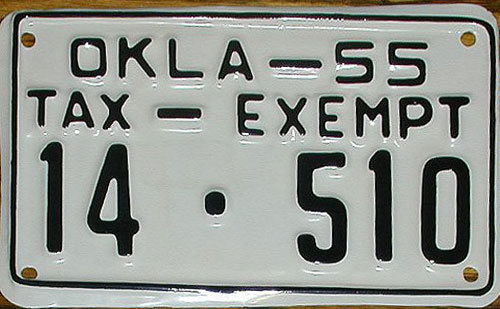 1955 Tax Exempt issue. Embossed steel
1955 Tax Exempt issue. Embossed steel
 1956 Tax Exempt issue. Embossed steel
1956 Tax Exempt issue. Embossed steel
 1957 Tax Exempt issue. Embossed steel
1957 Tax Exempt issue. Embossed steel
 1944 Tax Exempt issue. Embossed steel
1944 Tax Exempt issue. Embossed steel
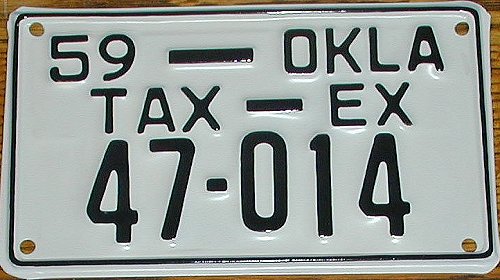 1959 Tax Exempt issue. Embossed steel
1959 Tax Exempt issue. Embossed steel
For 1960, Tax Exempt license plates in Oklahoma went to the continental standard measurement of 6 inches by 12 inches and had the words TAX EXEMPT fully spelled-out at the bottom center of the plate. The usage by the Highway Patrol is still uncertain up until 1968, but for the purposes of consistency, we will continue with the assumption that tax exempt license plates were used by the Highway Patrol during this time.
 1960 Tax Exempt issue. Embossed steel
1960 Tax Exempt issue. Embossed steel
 1961 Tax Exempt issue. Embossed steel
1961 Tax Exempt issue. Embossed steel
 1961 Oklahoma passenger car license plate. County 1 (Oklahoma County)
1961 Oklahoma passenger car license plate. County 1 (Oklahoma County)  1962 Tax Exempt issue. Embossed steel
1962 Tax Exempt issue. Embossed steel
 1963 Tax Exempt issue. Embossed steel
1963 Tax Exempt issue. Embossed steel
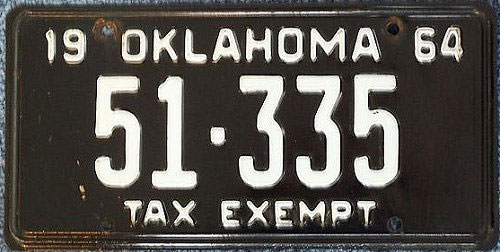 1964 Tax Exempt issue. Embossed steel
1964 Tax Exempt issue. Embossed steel
 1965 Tax Exempt issue. Embossed steel
1965 Tax Exempt issue. Embossed steel
 1966 Tax Exempt issue. Embossed steel
1966 Tax Exempt issue. Embossed steel
 1967 Tax Exempt issue. Embossed steel
1967 Tax Exempt issue. Embossed steel
 1968
1968  1968 Tax Exempt issue. Embossed steel
1968 Tax Exempt issue. Embossed steel
 1969 Tax Exempt issue. Embossed steel
1969 Tax Exempt issue. Embossed steel
 1970 Tax Exempt issue. Embossed steel
1970 Tax Exempt issue. Embossed steel
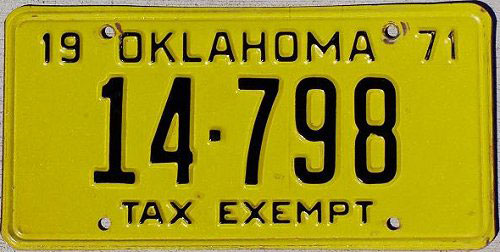 1971 Tax Exempt issue. Embossed steel
1971 Tax Exempt issue. Embossed steel
 1972 Tax Exempt issue. Embossed steel
1972 Tax Exempt issue. Embossed steel
 Early 1973 tax exempt issue. Embossed steel. Black over reflective yellow. Type issued prior to prison riot fire which destroyed 1.5 million license plates stored at the state penitentiary.
Early 1973 tax exempt issue. Embossed steel. Black over reflective yellow. Type issued prior to prison riot fire which destroyed 1.5 million license plates stored at the state penitentiary.
All license plates issued in Oklahoma were manufactured by the inmates at the Oklahoma State Penitentiary.
In late July of 1973, the prison was ravaged by rioting inmates who among other actions of destruction set fire to the facility causing upwards of 30 million dollars worth of damage. The record-breaking riot also destroyed 1.5 million Oklahoma license plates set for distribution for the 1974 issuance year which included the Tax Exempt license plates to be used by the state's Highway Patrol.
As a result, there are two different 1973 Tax Exempt license plates used by the state of Oklahoma for that year.
The "Pre-fire plate" was a standard 6" x 12" embossed steel plate with black embossed characters over reflective yellow. The plate also featured a step border and four round mounting holes in the standard position. 19 OKLAHOMA 73 was embossed along the top of the plate with the state name centered between the upper mounting holes. The Tax Exempt designation was captured by an emblem of the letter E inside a vertical diamond shaped perimeter much like the state of California used to denote a state exempt vehicle. These plates are known as "Diamond E's". This emblem was then followed by a short dash and a number up to five digits, in the 40 000 bloc at that time.
The "Post-fire plate" for 1973 had to be made out-of-state in Conway Arkansas by a company called Metal Stamping Corporation, later renamed Polyvend. Since the state was running out of Tax Exempt license plates for issuance in Oklahoma (not only for the Highway Patrol) MSC was tasked with producing to handle the shortages of various types of Oklahoma license plates that had been damaged in the fire including the Diamond E tax exempt plates. These plates were formatted the same as the "Pre-Fire plates", however they had an embossed border painted in black and used distinctively different dies, as well as a darker shade of yellow background. These were the only differences from the original home-spun 1973 version from earlier in the year.
Since all the 1974 license plates for the coming year were destroyed by the fire, the 1973 license plates were validated for 1974 with a decal. The black over white decal measured 1" x 5/8" with the word EXEMPT reading vertically on left margin followed by 74 above a 5 digit serial number beginning with a TL prefix and OKLA vertically on the right margin.
Both types of 1973 tax exempt plates were validated for 1974 with the decal.
 Late 1973 Tax Exempt issue.
Late 1973 Tax Exempt issue. 
 1975 Diamond E Tax Exempt issue. Embossed steel
1975 Diamond E Tax Exempt issue. Embossed steel
 1976 Diamond E Tax Exempt issue. Embossed steel
1976 Diamond E Tax Exempt issue. Embossed steel
 1977 Diamond E Tax Exempt issue. Embossed steel
1977 Diamond E Tax Exempt issue. Embossed steel

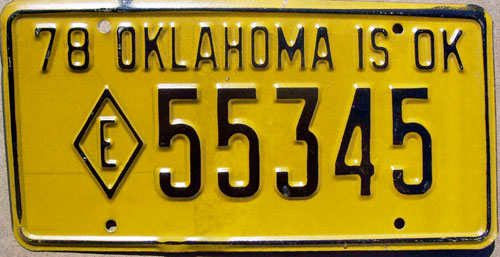 1978 Diamond E Tax Exempt issue. Embossed steel
1978 Diamond E Tax Exempt issue. Embossed steel
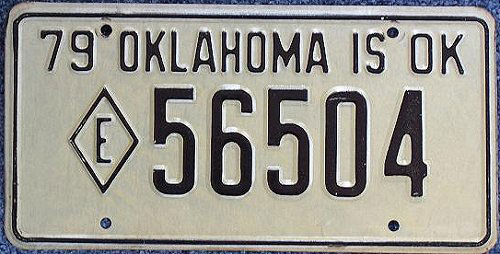 1979 Diamond E Tax Exempt painted border issue. Embossed steel
1979 Diamond E Tax Exempt painted border issue. Embossed steel
 1979 Diamond E Tax Exempt step border issue. Embossed steel
1979 Diamond E Tax Exempt step border issue. Embossed steel
 1980 Diamond E Tax Exempt issue. Embossed steel
1980 Diamond E Tax Exempt issue. Embossed steel
In 1981, marked Oklahoma Highway Patrol vehicles began to run STATE marked license plates in lieu of the previous Diamond E tax exempt license plates.
These plates were essentially state government use only and were colored black over reflective white on embossed steel. The earlier versions have OKLAHOMA IS OK embossed along the top center of the plate between the upper mounting holes. Below that a registration number beginning with the number 1 followed by a small state silhouette hyphen and a number up to four digits. Embossed at the bottom center of the plate is the word STATE.
These plates were multi-year use until the early 1990's.
 1981-1989 State vehicle issue.
1981-1989 State vehicle issue.
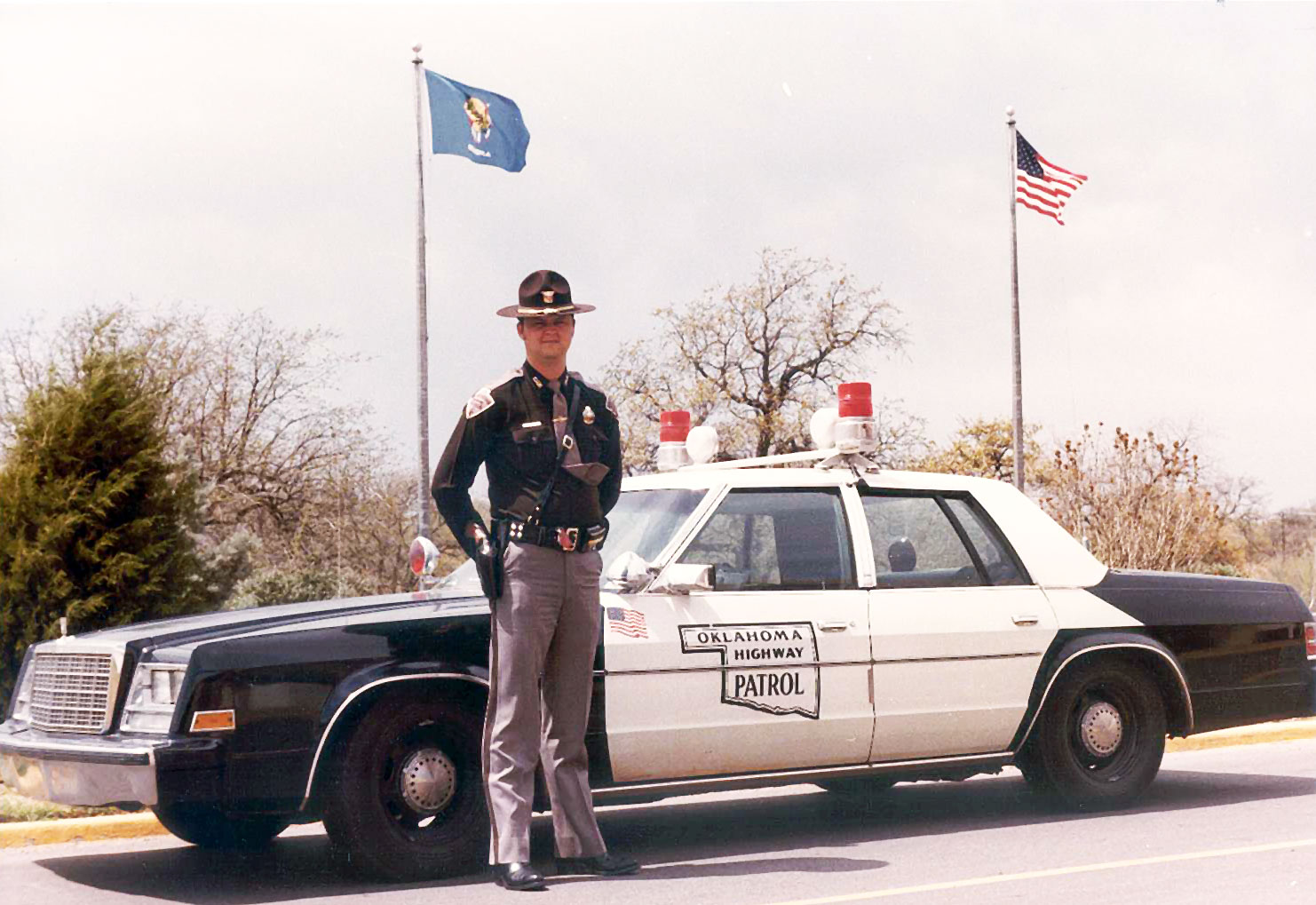




In 1989, the state of Oklahoma issued new graphic license plates to all motorists in the Sooner State. The Oklahoma Highway Patrol had the benefit of being issued these attractive new graphic license plates as well, but with the added bonus of having a distinctive designation exclusive to the OHP.
The plate is made of embossed steel with black raised characters. There is a lightly debossed validation decal navel in each of the upper corners with a short rectangular bar at the upper insets. There is also a lightly debossed vertical crease in the center of the plate. The state name OKLAHOMA and OK! is silkscreened in black stylized font at the top center of the plate. In the immediate center of the plate is the image of an Osage Indian Battle Shield silkscreened in buckskin, green red black and white. This image acts as a separator for the prefix OHP and a number up to three digits. OKLAHOMA HIGHWAY PATROL is silkscreened in black along the bottom center of the plate between the lower mounting holes.
 1989-circa 2012 issue. Embossed steel.
1989-circa 2012 issue. Embossed steel.


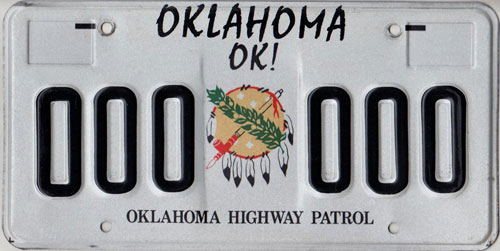 1989-circa 2012 SAMPLE issue. Embossed steel.
1989-circa 2012 SAMPLE issue. Embossed steel.



2012 marked the 75th Anniversary of the Oklahoma Highway Patrol. As part of the Diamond Anniversary, the agency had special graphic license plates commissioned for its marked fleet.
The plate was made of silkscreened aluminum with the only embossed feature being the step border around the perimeter of the plate. The background was reflective white with a stylized OKLAHOMA silkscreened in black at the top center between the upper two mounting holes. The center field of the plate comprised of the OHP prefix in black on the left side of the plate and the three digit assignment number on the right center side of the plate.
The center of the plate displayed an ornate motif of the circular OHP/state seal emblem with an OHP top scroll and TROOPER lower scroll on the emblem. A parchment scroll design spanned the area below the center design with 1937 75th Anniversary 2012 inscribed. A small bar code in black appears on the step border to the right of the lower right mounting hole.
The plates were apparently only displayed until 2013.
 2012 75th Anniversary issue. Silkscreened aluminum.
2012 75th Anniversary issue. Silkscreened aluminum.
Despite a very attractive license plate issued for the Oklahoma Highway Patrol's 75th Anniversary just a year earlier, in 2013 the OHP went to a different graphic layout for the marked fleet's license plates. The new plates were once again entirely silkscreened aluminum plates with a step-border. The background was reflective white with a stylized OKLAHOMA silkscreened in black at the top center between the upper two mounting holes. The center field of the plate comprised of the OHP prefix in black on the left side of the plate and the three digit assignment number on the right center side of the plate.
The center of the plate has a detailed depiction of the Oklahoma state seal in blue and gold over white.
OKLAHOMA HIGHWAY PATROL is silkscreened in black between the lower mounting holes.
 2013-Current issue.
2013-Current issue. 


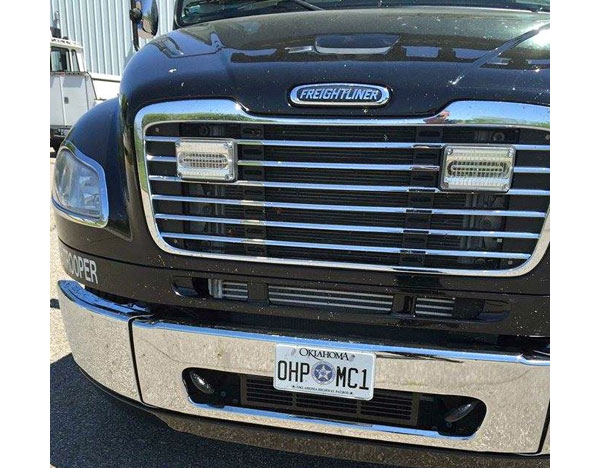
 OKHP Freightliner transporter used for Motorcycle Safety Education Program.
OKHP Freightliner transporter used for Motorcycle Safety Education Program.
Oklahoma Highway Patrol motorcycle usage history consists of the following: They had 28 motorcycles for patrol in 1938 and 1939, then went down to 24 in 1940. There is absolutely nothing else about motorcycle use by the OHP until about 2009 when the OHP purchased a Hayabusa motorcycle to be used on patrol. There may have been more added since then.
Special license plates were issued with numbers beginning at OHP 999 and working their way backwards so as to not coincide with other OHP numbers. The plates are made of embossed aluminum and are colored black over reflective white. The state abbreviation OK is embossed at the top center of the plate with OHP### embossed over OKLAHOMA HIGHWAY PATROL silkscreened in black at the bottom.
 Circa 2010-current OHP motorcycle issue.
Circa 2010-current OHP motorcycle issue.  OHP Hayabusa
OHP Hayabusa 2012 75th Anniversary issue motorcycle plate.
2012 75th Anniversary issue motorcycle plate.
 2020
2020 Very few special issues of OHP license plates or other ephemera have been discovered.
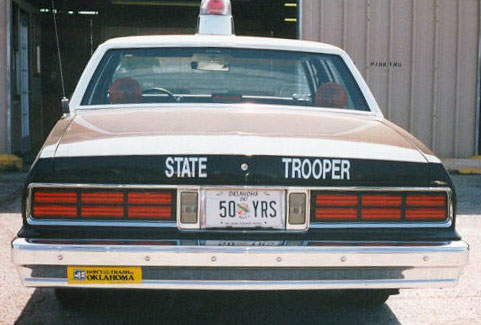 Special 50 Years plate circa 1987.
Special 50 Years plate circa 1987. Current use All-Flate OHP Retiree.
Current use All-Flate OHP Retiree. Current OHP Retiree Sample issue.
Current OHP Retiree Sample issue. Current use OK HP Retired issue.
Current use OK HP Retired issue.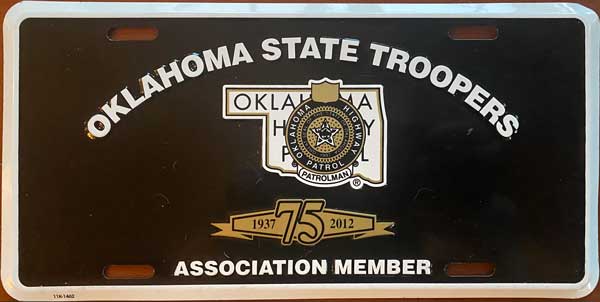 Oklahoma State Troopers Asscociation
Oklahoma State Troopers Asscociation